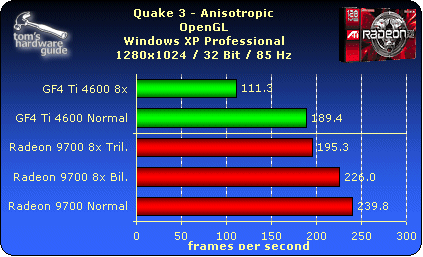ATi Radeon 9700 PRO - Pretender To The Throne
3D Mark 2001 SE 330 - Anisotropic - Dragothic
The detailed results of the Dragothic test show how much of a nosedive the GeForce4's performance takes when anisotropic filtering is enabled. In comparison, the performance hit for enabling anisotropic filtering is marginal on the Radeon.
Quake 3 - Anisotropic
The Radeon also proved to be superior in OpenGL. However, ATi's current Catalyst driver has a bug. Changing the quality of the filter from bilinear to trilinear (or vice versa) in the driver menu had absolutely no effect. During testing, we had to set the filtering level by hand, by changing a key in the Windows registry.
ATi's implementation of anisotropic filtering clearly offers superior performance. While NVIDIA can truthfully say that their scores were achieved using a more "honest" method, this doesn't really change anything if the results of these two methods are practically indistinguishable from one another. Admittedly, there were one or two times when ATi's algorithm had trouble selecting the appropriate filtering level because of an especially awkward viewing angle - but even then the better performance more than outweighed that slight and momentary inconvenience. As a last resort, you could also still crank the filtering settings up all the way to 16x aniso and still get a higher frame rate than with NVIDIA's honest method.
Maybe ATi should simply include a complete but unoptimized implementation of anisotropic filtering in its driver (i.e. one that is set by hand and doesn't automatically select the "appropriate" filtering level). That way, everybody would be happy.
Get Tom's Hardware's best news and in-depth reviews, straight to your inbox.
Current page: 3D Mark 2001 SE 330 - Anisotropic - Dragothic
Prev Page Anisotropic Filtering Next Page Maximum Quality - Aniso + FSAA




